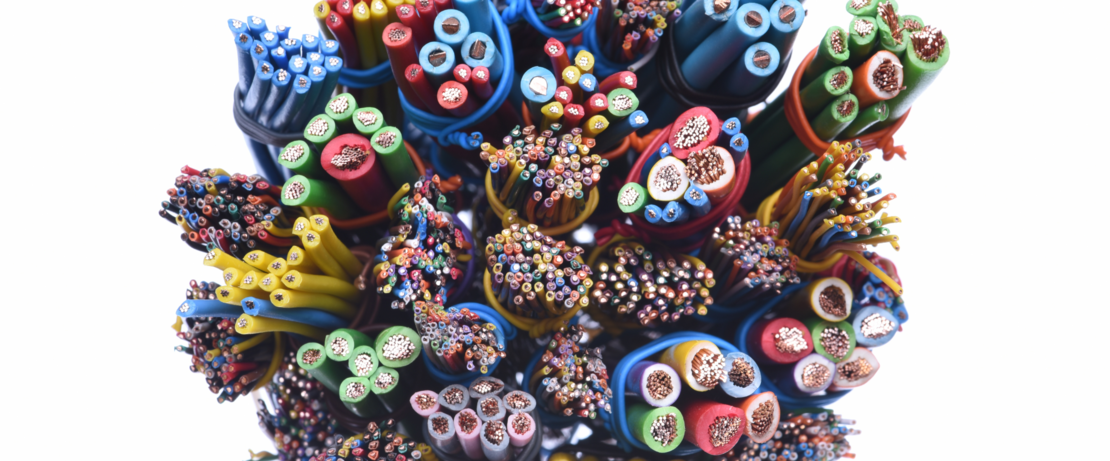
Dynasylan® SILFIN 301 simplifies production of crosslinked HFFR cables
In Europe, halogen-free, flame-retardant cables are a standard feature for guaranteeing safety in public places. Producing these high-safety cables poses a challenge for manufacturers, as compounds containing flame retardants are often difficult to process with commonly used extrusion machines. A new silane product from Evonik is now supporting cable producers in their work.
Evonik has developed an innovative silane product which makes the production of halogen-free flame-retardant cables (HFFR) significantly easier and more efficient. Dynasylan® SILFIN 301 grants greater flexibility when processing filled compounds for insulating these especially sophisticated cables.
Dynasylan® SILFIN 301, a product from Evonik Silanes’ portfolio of Dynasylan® SILFIN products specially formulated for the cable and pipe industry, is tailored for the Sioplas® process for crosslinking filled polyolefins.
Compounding and crosslinking
Manufacturers generally use crosslinked polyethylene compounds (PEX) for the insulation of cables. Polyethylene is halogen-free and has outstanding insulation properties. To produce PEX, the polymer needs to be compounded with mineral fillers using silanes and other additives, and then crosslinked in order to improve the functioning of the cable coatings.
An especially economical crosslinking method is the silane crosslinking (PEX-b) of cables and pipes. This is a two-stage process – in the first stage, vinylsilanes are grafted on polyethylene chains with small amounts of peroxide in an extruder, for example applying the commonly used Sioplas® process. The special silanes from the Dynasylan® SILFIN product range are especially suitable for this, as their chemical structures are tailored to the polymers used in the cable industry. This is followed by the actual crosslinking using water, which can be triggered in a water quench, steam chamber or at the ambient temperature.
Among other things, this crosslinking improves the abrasion resistance and stress crack resistance of the insulating layer, while also making the cable more flexible. Most importantly, however, the original thermoplastic polyethylene no longer melts and features greater thermomechanical stability.
Dynasylan® SILFIN 301 expands the processing window
Flame-retardant compounds for crosslinked HFFR cables are difficult to process due to their high filler content. For example, this may result in the premature degradation of the applied flame retardant, premature crosslinking may set in or the surfaces of the extrudates may be of poor quality. In any case, the surface quality, mechanical properties, crosslinking quality and fire behavior of the produced cables would not meet the required specifications.
“Our new Dynasylan® SILFIN 301 is a ready-to-use system which makes it easier for cable manufacturers to process their products in an extruder and simplifies the subsequent crosslinking,” states Helmut Büsser, Director Marketing at Evonik’s Silanes business line. The innovative silane preparation consists of vinylsilane and peroxide. It is optimized to the Sioplas® process for crosslinking filled polymers and significantly expands the processing window for the compounder and the cable manufacturer.
Dynasylan® SILFIN 301 reacts up to ten times slower than other vinylsilanes. This has the beneficial effect that the compound is less sensitive to moisture, thus considerably lowering the risk of premature crosslinking during processing. Moreover, Dynasylan® SILFIN 301 improves the electrical and mechanical properties of the HFFR compounds and reduces the absorption of water by the polymer.
Higher throughput during production of HFFR cables
“The expanded processing window allows more stable production and leads to a higher production output with less production waste. There is less waste and it saves materials.” As such, Dynasylan® SILFIN 301 also enables economical production of the high-safety cables. The already outstanding mechanical and electrical characteristics of the final product remain unchanged, while HFFR cables guarantee efficient flame-retarding properties.
The especially safe HFFR cables are used for fire protection in places such as public buildings and public transportation. The jacket is extremely flame-resistant, self-extinguishing and produces minimal smoke. In case of fire, HFFR cables prevent the flames from spreading. These special cables must satisfy stringent standards.
Silanes as an agent
HFFR cables are standard in Europe in particular. Cable jackets made of plastics such as PVC, which contain halogens such as chlorine or bromine, are also flame retardant, but they release toxic substances in a fire.
On the other hand, halogen-free polymers with good insulation properties, such as polyethylene or ethylene vinyl acetate (EVA), would be highly flammable without treatment. In order for them to be used for insulating HFFR cables, mineral fillers such as aluminum trihydroxide or magnesium dihydroxide are added as flame-retardant agents. These significantly reduce the flammability and smoke propagation of the cables during fires.
Silanes serve as agents during this process: They trigger the linking of the inorganic filler materials with the organic plastic on a molecular level and generate the good adhesive properties needed for the thermal stability of the compound. The subsequent crosslinking of the polymer improves the thermal-mechanical stability of the cables.

